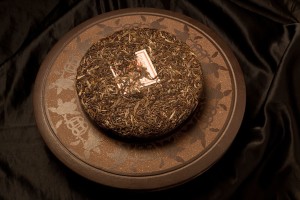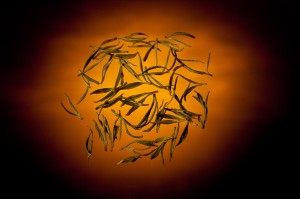Some thoughts about the beauty of tea…..
Blind people can enjoy tea, of course, but as with the rest of their lives, they are denied a beautiful dimension–the visual. Forget about drinking tea for a minute. Let’s extol the drink for its delightful impact on the eyes.
Tight cakes of pu-erh tea are beautiful in their own right, with the darkened leaves compressed into intertwined, unfathomably complex blocks. Aroma aside, each cake is a singular mysterious matrix of formerly green leaves tenderly plucked and processed to create a whole, till they are plucked from the cake to create a brew.
A first-time tea drinker can be surprised by the startling color of tea soup. Dark brown leaves might be expected to produce a liquid of the same hue, but the magic of infusion can turn muddy brown to golden yellow. The soup of the Wuyi Oolong Rock Pure Da Hong Pao tea — a Wild & Bare Co. favorite — is as yellow as the most glistening lemon, the most shimmering field of rapeseed, the most vibrant sapphire. It literally is a sight to behold–before drinking. In the mind, the tea still glitters golden as it flows into the belly.
In the same way does Keeman Mao Feng Black Tea transform itself when embroiled in hot water, but the soup for this tea is not golden. The dried black leaves of this tea become scarlet, a pulsing red liquid that begs for peering into as one does a blood-red sun at day’s end. Suspending thought just to bask in the color of the tea is a reconciliation of mind and spirit.
Dried white tea leaves are among the most delicate of tea sights, including the leaves of the White Tipped Silver Needle Bai Hao Yin Zhen tea from southern Fujian. The leaves are light brown, which is an OK color but quite bland, wouldn’t you say? Yet the neutral color is the perfect backdrop for the tiny, silvery white hairs that sprout thickly along the needle-shaped leaf. The fine down is akin to that found on a baby, or to the delicate tendrils sometimes seen through microscopes. The gentle down helps produce a velvety drink.
Other teas are green–including the jade green dried leaves of Handmade Imperial Zhu Ye Qing, or the dark green leaves of Handmade Premium Liu An Gua Pian. It is true that the entire rainbow of color is not found in tea–a light blue tea soup probably should be emptied down the drain and an investigation begun–but the golds and greens and reds of the tea kingdom genuinely enrich a tea brewer.
Perhaps the most visually dramatic sight at tea is provided by the unfolding of blooming or flowering tea. This family of teas is crafted in the same way a piece of art is crafted, with painstaking labor. But unlike the sculpted rock, the thrown clay, or the brightly brushed canvas, the beauty of blooming tea is not revealed until hot water is added to a glass cup containing the tea. That is when the leaves unfold to reveal a flower blossom. The infused color of the leaf and vibrancy of the blossom combined with the actual “blooming” action of the tea balls can be breathtaking.
Drink the tea? Of course. But before you do, don’t deprive yourself of the pleasure of seeing it.
++
This article was provided by Rebecca Nolan of Wild and Bare Tea. Connect with their teas and their websites!
http://www.facebook.com/wild.
http://twitter.com/WildandBare



